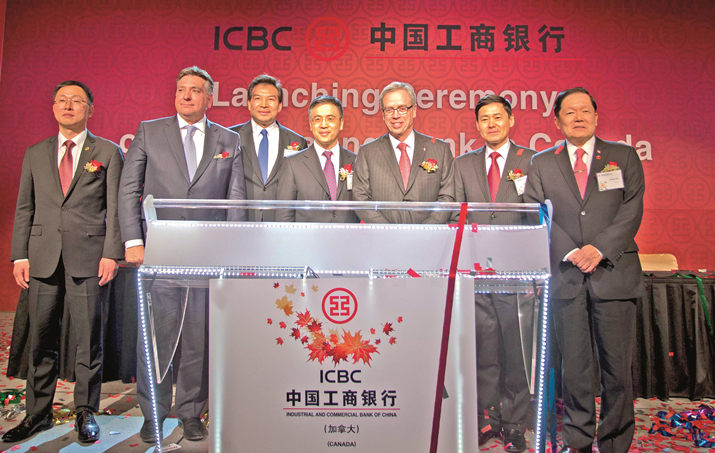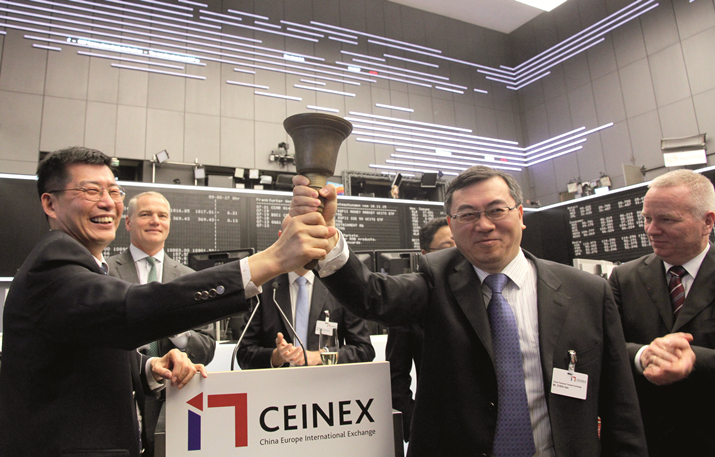|
|||||||||||
|
|
| Joining the Club |
| IMF's inclusion of yuan as reserve currency brings China into global monetary system. |
| By Zhou Xiaoyan | VOL. 8 January 2016 |
 |
| The first yuan clearing bank in North America is established by the Industrial and Commercial Bank of China in Toronto, Canada, on March 24, 2015 |
As China entered the big league with the yuan included in the International Monetary Fund’s (IMF) basket of reserve currencies, analysts are looking to see what the next move will be.
With China continuing reforms and opening up its financial markets, experts expect more changes, including allowing the yuan’s value to be determined, to a greater extent, by the market, to push it onto the global stage.
The yuan was added as the fifth currency in the IMF’s Special Drawing Rights (SDR) basket on November 30, 2015, besides the U.S. dollar, euro, Japanese yen and pound sterling. The expansion, to be effective from October 1, 2016, marks a historic moment in China’s journey toward globalizing its currency and underscores its rising financial and economic heft.
Yi Gang, Vice Governor of the People’s Bank of China (PBC), the country’s central bank, said the yuan’s inclusion in the SDR basket is just the beginning. China has a long way to go before it closes the gap with more mature financial markets.
''Joining the SDR means the world will expect more from China in its financial and economic reforms. Therefore, China should learn from developed countries as well as other developing countries and emerging markets in a modest manner," Yi said during a press briefing on December 1, 2015. ''China will press ahead with its reforms and opening up to consolidate its status as a reserve currency in the SDR basket.
The SDR is an international reserve asset created by the IMF in 1969 to supplement its member countries’ official reserves. SDRs are periodically allocated to IMF members based on each country’s quota in the IMF. The composition of the SDR basket is reviewed every five years. As of September 2015, 204.1 billion SDRs (equivalent to about $280 billion) had been allocated.
The PBC welcomed the IMF decision, calling it an acknowledgement of China’s economic development, reform and opening up.
''The inclusion of the yuan in the SDR basket will increase the representativeness and attractiveness of the SDR, and help improve the current international monetary system, which will benefit both China and the rest of the world," it said in a statement. "It also means that the international community expects China to play a bigger role in the international economic and financial system."
In an announcement following a vote by the IMF’s executive board, Managing Director Christine Lagarde said the yuan meets all existing criteria and is determined to be a freely usable currency.
''The continuation and deepening of these efforts will bring about a more robust international monetary and financial system, which in turn will support the growth and stability of China and the global economy," Lagarde said in her announcement.
She called the decision "an important milestone in the integration of the Chinese economy into the global financial system" and an important validation of China’s efforts to reform its monetary and financial systems.
Multiple milestones
The yuan has passed multiple milestones. It is now the world’s fourth most-used payment currency, having overtaken the yen. In August 2015, the yuan accounted for 2.79 percent of global payments in terms of value, according to the Society for Worldwide Interbank Financial Telecommunication.
The currency’s elevation to the club of elite reserve currencies represents a historic moment for China, akin to when it was admitted to the World Trade Organization in 2001, said Guo Tianyong, a finance professor with the Beijing-based Central University of Finance and Economics.
''It means the international community has recognized the yuan’s capability in shouldering the responsibilities of a global currency," Xu Hongcai, Director of the Economic Research Department at China Center for International Economic Exchanged (CCIEE), said. "It will help facilitate further globalization of the yuan."
Xu said the inclusion marks an increase in the yuan’s international credit, which will pave the way for broader use of the currency in global trade and finance as well as help lower costs and exchange rate risks for users of the currency.
A report by the Shanghai-based Haitong Securities Co. forecasts the yuan’s exchange rate will become more flexible in the future, with the daily trading band expanding to 3 percent or more as the PBC further loosens its grip over the currency following the IMF decision. On March 17, 2014, the PBC revised the way the yuan’s daily trading band is calculated. It set a daily midpoint for the yuan so that the currency can be traded within a 2-percent range. Previously, the central bank had allowed the currency to fluctuate just 1 percent of the midpoint.
In August 2015, China changed its central parity system to better reflect market development on the yuan-dollar exchange rate, another step toward market forces determining the value of the Chinese currency. The central bank has made other large strides in recent years to reform the financial markets and further open up its capital account.
It is these reforms that have led to China’s economic progress and the IMF decision, said Cao Fengqi, Director of the Research Center for Finance and Securities at Peking University.
Cao has no doubt the yuan will become a global currency. "It’s only a matter of time," he said.
However, Xu has a caveat: the government cannot be complacent about the yuan’s inclusion. The currency still has a long way to go before it is considered a global currency. China will face fresh pressure now, needing to pay more attention to fluctuations in financial markets, both at home and abroad.
''I think the opening up of capital account should be pushed forward in a steady manner. Massive inflow and outflow of capital could be quite normal in the future," Xu added. He also recommended the government have additional supervision over speculative capital flows that could lead to market instability. The supervisory measures could include a Tobin tax - a tax on foreign exchange transactions.
 |
| Wu Jianhong (left) and Chen Han (second right), executive board members of the China Europe International Exchange (CEINEX), ring the bell to inaugurate the exchange in Frankfurt, Germany, on November 18, 2015 |
Next big steps
The Haitong Securities report also predicts three major reforms following the IMF decision: a yuan exchange rate formation mechanism, management of international capital flow, and further opening up of the domestic bond market.
Xu said China should step up efforts to encourage more foreign borrowers to issue yuan-denominated bonds - also known as Panda bonds - on the Chinese mainland. The development of the bonds lagged in the past decade because markets expected the yuan to appreciate against the dollar and have a higher interest rate, Xu said.
''But these two criteria are changing as the value of the yuan is fluctuating both ways against the dollar and the interest rate gap between the two currencies is narrowing," Xu added.
On November 25, 2015, the PBC announced that the first batch of foreign central banks and similar institutions have been allowed to enter the Chinese interbank foreign exchange market. Xu said global financial institutions should be allowed too.
''Global financial institutions, such as the World Bank, Asian Development Bank, European Bank for Reconstruction and Development, and the China-proposed Asian Infrastructure Investment Bank, should be allowed into China’s interbank forex market as well," Xu said. "They should be encouraged to issue yuan-denominated bonds to facilitate connectivity projects along the Silk Road Economic Belt and 21st Century Maritime Silk Road proposed by China."
Greater benefits
Ultimately, the IMF’s decision to include the yuan in the SDR basket will impact more than just markets, said Lian Ping, chief economist with the Bank of Communications. It will make it easier for ordinary Chinese to consume and invest overseas because more countries will recognize the currency. "In the future, Chinese people won’t have to buy foreign currencies before traveling abroad. Taking the yuan will be enough," he said.
Desmond Fu, a trader at investment firm Western Asset, told China Daily that the IMF decision marks recognition of the yuan’s rising role in global financial markets, both as a reserve and settlement currency. "This is beneficial to both China and its trading partners as bilateral trades can be transacted without reference to a third-party currency," he said.
Wang Tao, chief China economist with financial services company UBS, said the yuan’s inclusion in the SDR basket will pave the way for the emergence, over time, of yuan-denominated assets constituting a significant share of global reserves.
But Xu warned that the SDR currency basket is limited in its usefulness. "It has not been widely accepted in the financial system," he said.
|
|||
| Copyright ChinAfrica All right reserved 京ICP备08005356号 |